There are some furry critters that will nibble just a few flowers or fresh shoots from your garden, and that’s okay. But rabbits, well, they can go too far.
When they start consuming such large portions of your precious flowering plants that you stop using the word “cute” to describe the babies, or you don’t find Bugs Bunny to be quite so funny anymore, well, it’s time to take action.
While there are lots of planting, maintenance, and fencing strategies that might keep rabbits out of your garden, one of the easiest tactics is simply to grow flowering plants that the rabbits will leave alone.
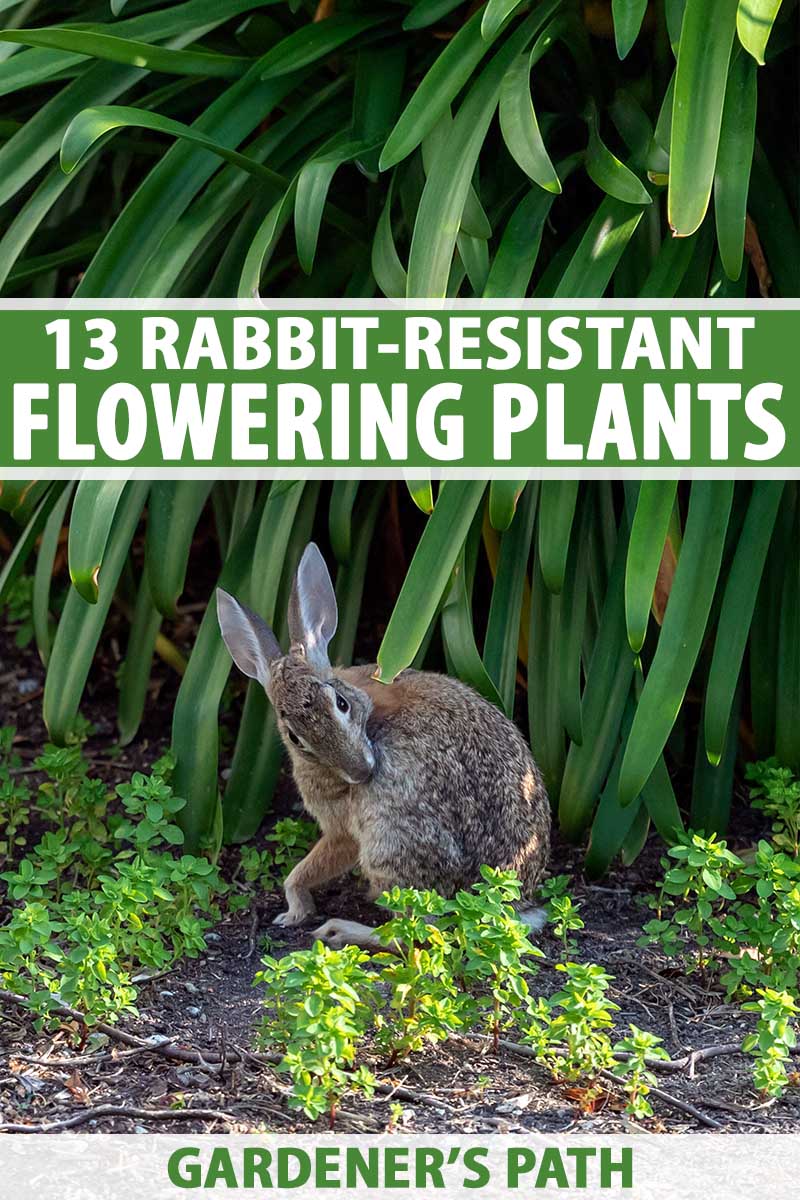
We link to vendors to help you find relevant products. If you buy from one of our links, we may earn a commission.
If these big-eared pests have become a big problem for you, there are lots of attractive flowering options they won’t gobble.
Just remember, no plant is guaranteed to be 100 percent rabbit-proof. There’s always that youngster who will eat anything – once.
Or, if forage is in super short supply in your area, or a drought or extra-rainy season is killing off their preferred food sources, they may chomp on anything to survive.
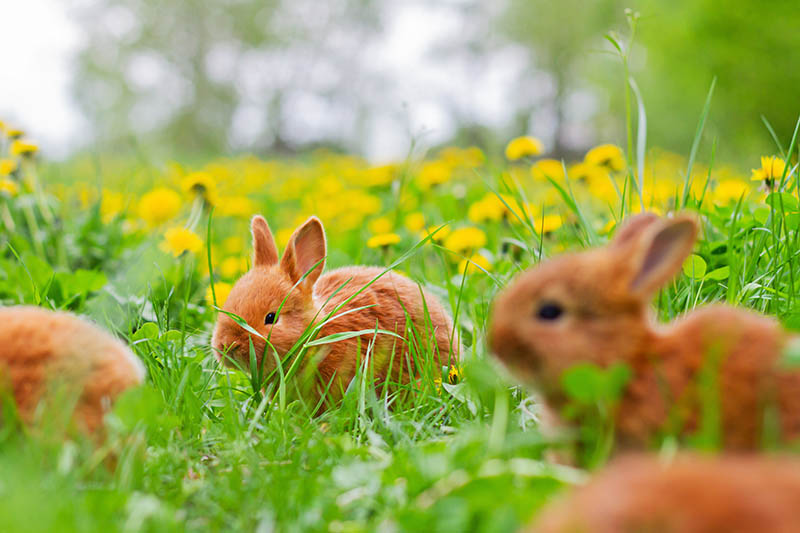
Under normal conditions in a temperate and thriving landscape, these choices will help you say goodbye to rabbit diners. Here’s the A-list I’ll be sharing:
13 Flowering Plants Rabbits Will Leave Alone
Ready to grow some beautiful flowers that rabbits won’t touch? Consider these:
1. Allium
Ornamental perennial allium (Allium spp.) bulbs bloom in soul-satisfying shades of blue, purple, or bright white, and options range from six-inch minis (A. christophii) to six-foot mammoths (A. giganteum).
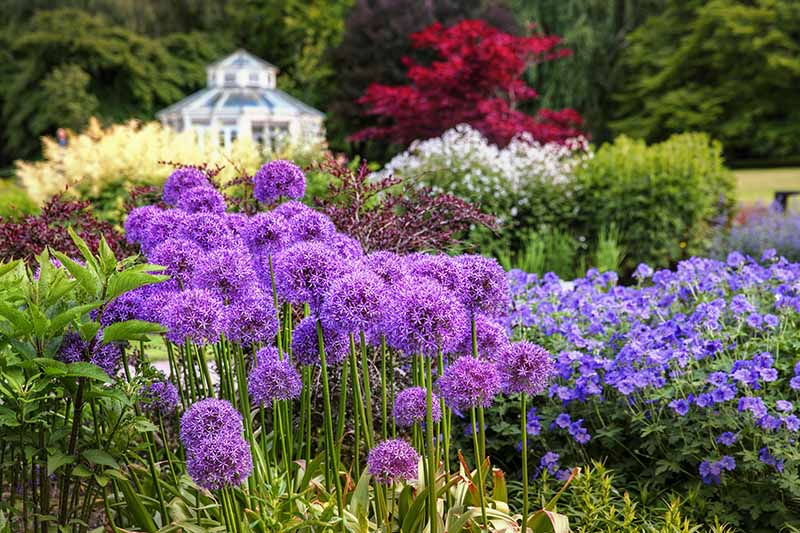
You may not enjoy their pungent scent – they’re also known as ornamental onions for a reason – but rest assured the furry rascals won’t like their onion smell either.
Plant flowering allium in borders, rock gardens, or anywhere you need a splash of color.
They’ll do well in the sun and can tolerate partial shade, growing well in Zones 4 to 9.
An all-in-one mix of purple and white allium bulbs is available from Eden Brothers in bags of six, 12, or 18.
Learn more about how to grow flowering alliums in this guide.
2. Anise Hyssop
Not only are the bright blue blooms of this mint relative bird and butterfly magnets, you can use anise hyssop (Agastache foeniculum) leaves in your cooking in place of mint.
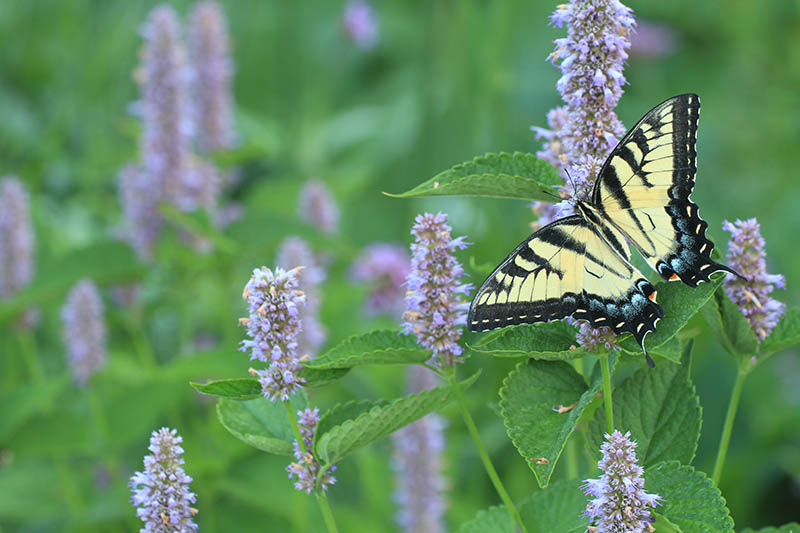
Bugs and his buddies, on the other hand, don’t like these flowering plants that grow two to four feet tall on square stems.
Plan for the flowers to bloom from midsummer to fall, and think about propagating cuttings to plant in other places where bunnies like to dine.
Anise hyssop is hardy in Zones 4 to 9, and will grow in full sun to part shade.
You can purchase anise hyssop plants in three-inch containers from Nature Hills Nursery.
Read more about growing anise hyssop in your garden.
3. Bee Balm
Bees and other pollinators adore it, rabbits, not so much.
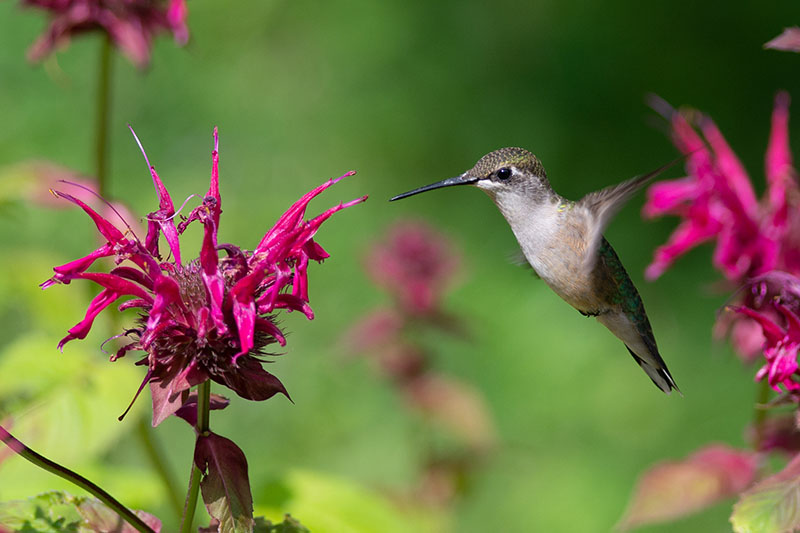
This perennial herb grows three to four feet tall and blooms in a profusion of pink, red, violet, or white starting in summer and not letting up until early autumn.
Bee balm (Monarda spp.) requires full sun and prefers moist soil that drains well. It’s hardy in Zones 4 to 9.
You can find bee balm seeds at Eden Brothers in packets of various sizes.
You can learn more about its medicinal value by reading our bee balm growing guide.
4. Begonia
These old-fashioned beauties add a punch of color anywhere it’s needed in the flower bed.
Wax begonias (Begonia semperflorens) may have green or bronzed leaves and pink, white, or red single or double blooms.
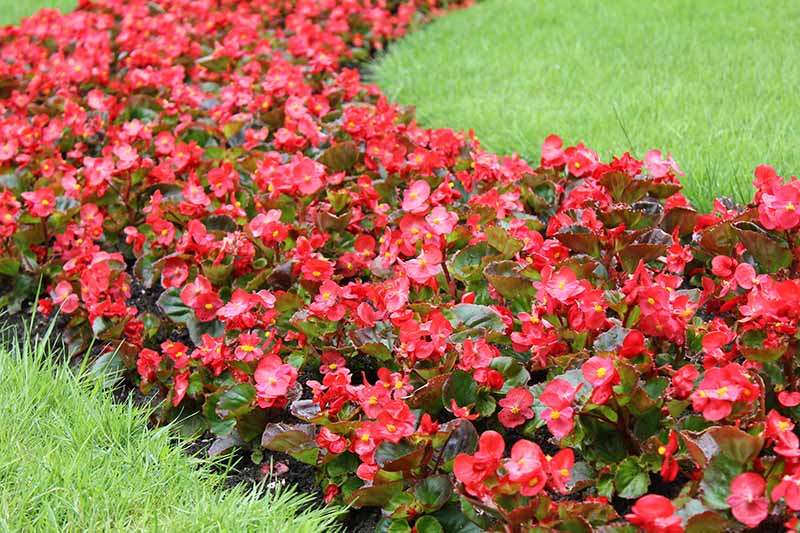
You’ll find flowering begonias that will thrive in whatever light you’re able to offer, from full sun to part shade.
My favorite part of growing these to deter munching bunnies is that you can also take cuttings to root and plant in containers indoors in the winter.
You can grow begonias as annuals pretty much anywhere in the US, or they can be grown as perennials in Zones 10 to 11.
Begonia plants in pint containers, hanging baskets, and six-packs are available from Home Depot.
5. Black-Eyed Susan
This cottage garden favorite is one flowering perennial that marauding rabbits will pass over.
Plus, it provides those appealing daisy-type golden or deep red flowers in average soil. It will need full sun, though, and it won’t grow well in containers, so plan to plant it in raised beds or in the ground.
Otherwise, black-eyed Susans (Rudbeckia hirta) are low maintenance and will tolerate drought. They’re hardy in Zones 3 to 9.
You can find black-eyed Susan seeds in packets of various sizes available at Eden Brothers.
Learn more about growing black-eyed Susans in this guide.
6. Catmint
Catnip’s more subdued cousin catmint (Nepeta cataria) grows in average soil and produces subtly scented gray-green leaves followed by blue, pink, or white blooms.

They’ll keep coming throughout the summer if you cut it back mid-season.
This easygoing plant will grow in full sun to part shade and just about any type of well-draining soil. Average is fine!
This perennial gets about a foot tall and is hardy in Zones 3-9.
Catmint seeds are available from Eden Brothers in various packet sizes.
You can also buy pots of ‘Walker’s Low’ catmint from Nature Hills Nursery.
Read more about growing catmint here.
7. Chives
Chives (Allium schoenoprasum) are members of the onion family that includes garlic, leeks, and spring onions. These are a secret weapon against bunnies who are treating your garden like their personal salad bowl.
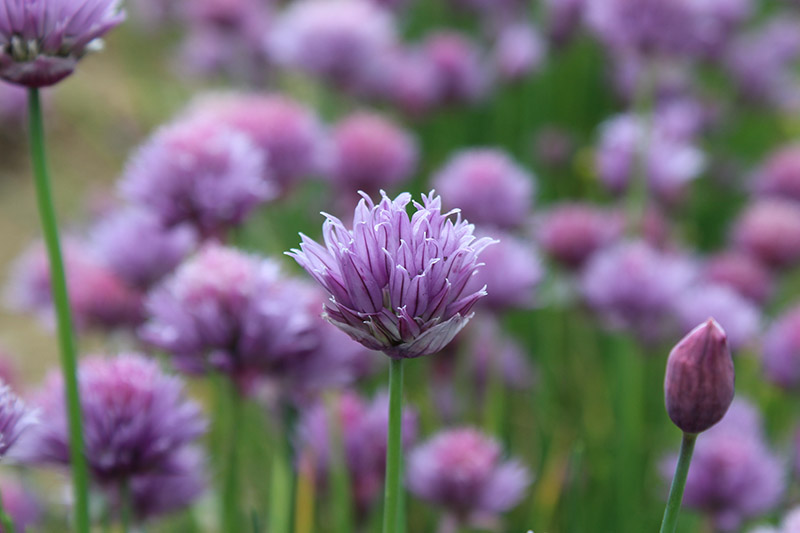
Like the ornamental Alliums described above, chives make a good flower garden addition, too, since they boast beautiful light purple flowering pom-poms late in the season.
They’re also tasty perennials. Oh, and this is probably the only natural, non-toxic pest deterrent that tastes great as a topping on baked potatoes or baked into cheddar biscuits.
They grow best in fertile well-draining soil and full sun, though they’ll also persevere in part shade. And they’ll usually make a comeback if you let them reseed.
I have thoroughly enjoyed a garlic chive plant (A. tuberosum) I got more than a decade ago for this very reason, another allium relative with similar growing requirements and white clusters of blooms.
You can find common chive seeds (A. schoenoprasum) in various packet sizes available at Eden Brothers.
Check out our guide to learn more about growing chives.
8. Foxglove
You’ll be depriving certain hopping pests of dinner, but you won’t be missing out on drama or beauty when you grow these showy 18-inch-and-up spikes of pink, rose, white, and yellow flowers.
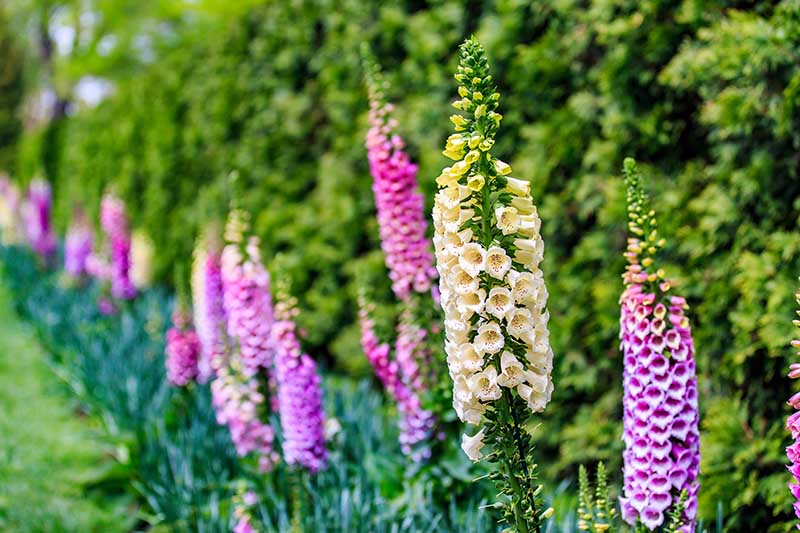
They’ll start busting out all over in June and continue the show through late summer.
It used to be that all foxgloves (Digitalis purpurea) were biennials, so they didn’t bloom until the second year after planting. Now, some new varieties have been bred to flower in year one.
All types of foxgloves are fairly easy to grow if you have moist, well-drained soil. Remember to keep them well-watered during dry spells.
They like part sun but are also a solid choice as a perennial for the shade garden. Old timers will tell you that the hotter your growing area, the more shade foxgloves require.
Most importantly, don’t plant foxglove anywhere young children will encounter them. They are poisonous!
Foxgloves are hardy in Zones 4 to 10.
You can find ‘Arctic Fox’ plants available at Burpee, or for mixed color seeds specially bred to bloom the first year, try ‘Foxy,’ also from Burpee.
Read more about growing foxglove here.
9. Hardy Geranium
Here’s another flowering plant that deters nibblers with its scent.
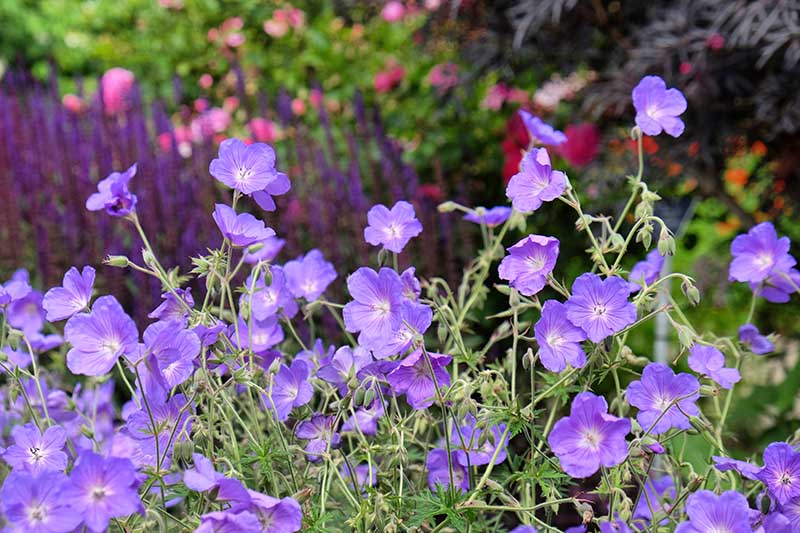
This is the hardy perennial I’m talking about, aka cranesbills (Geranium spp.), not those annual red geraniums that are actually a close relative, known botanically as Pelargonium.
Different varieties of hardy geraniums bloom in shades of blue, pink, purple, and white.
They produce mounds of dark green foliage and vibrant colored, five-petaled flowers. The leaves act as a deterrent with their subtle lemony scent.
They’re a great choice for native plant gardens, and areas with light shade or full morning sun.
One of the many reasons I love hardy geraniums is that you can readily grow more by rooting cuttings in water.
You’ll be rewarded with a long-lasting perennial that blooms from late spring to early fall.
Hardy geranium cultivars like ‘Rozanne’ are available in #1 containers from Nature Hills Nursery.
Learn more about cultivating and propagating cranesbill geraniums in our growing guide.
10. Oregano
The tasty herb with its tiny pink or white flowers is a culinary delight, just not to rabbits.

They have a tough time scaling raised bed walls, so plant oregano along the ground and save Thumper and Bugs’ favorites – like tender young petunias – for planting in raised beds or hanging baskets.
A perennial, oregano (Origanum vulgare) grows in average soil and tolerates drought and heat. It will need full sun to do its best. This summer favorite is hardy in Zones 5 to 10.
Greek oregano seeds are available in various packet sizes from True Leaf Market.
Check out our Greek oregano growing guide for more information.
11. Salvia
Our cute hopping buddies tend to leave this cheerful flowering plant alone, maybe because of its scent.
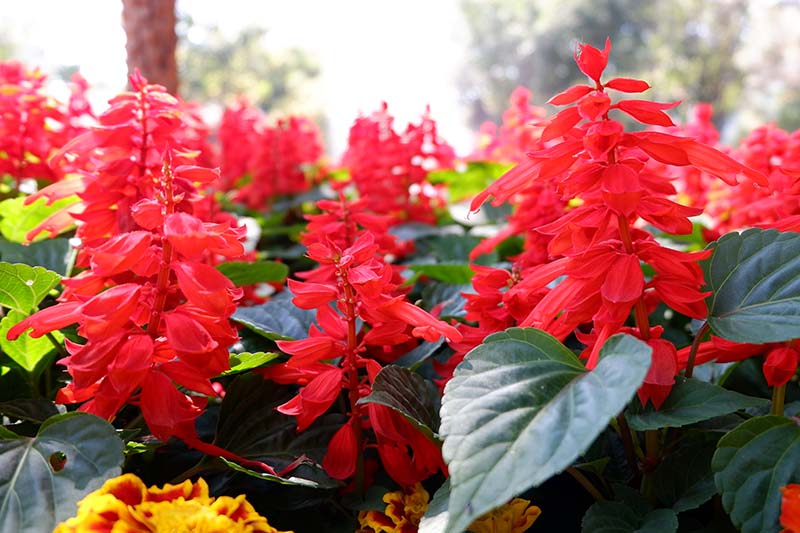
Salvia is a genus in the mint (Lamiaceae) family, so its aroma will probably be just fine for you.
It’s a handy option if you live where it’s hot or dry but still want brilliant color. In colder climes, salvia is also known for its chill tolerance.
And you’re bound to find at least one variety that suits you. Salvia can be perennial or annual, and some types are semi-woody sub-shrubs or ground covers.
If you’ve already planted your garden, you can find complementary salvia varieties in colors like red, purple, and blue that grow from one to five feet tall, depending on your selection.
‘Red Hot Sally II’ salvia seeds are available from True Leaf Market in packets of 1,000.
Take a look at our growing guide for the A to Z steps of growing this rabbit-resistant beauty.
12. Yarrow
This cottage garden, dried-flower, and bouquet favorite is also the rabbit’s least favorite. A win-win!
Yarrow (Achillea millefolium) is a drought resistant perennial that requires full sun and well-drained soil, and it grows best in Zones 3 to 9.
It’s dependable, long-blooming, and available in shades of pink, salmon, orange, red, white, and yellow, whatever you need.
Gold yarrow seeds are available by the packet or in bulk from Eden Brothers.
Find detailed information about growing yarrow in our guide.
And revel in the possibilities from our list of hardy yarrow cultivars to grow. How about neon yellow?
13. Zinnia
These bright, cheery annuals are easy to grow in full sun. They come in a variety of sizes, from dwarf miniatures to those that grow four or five feet tall.
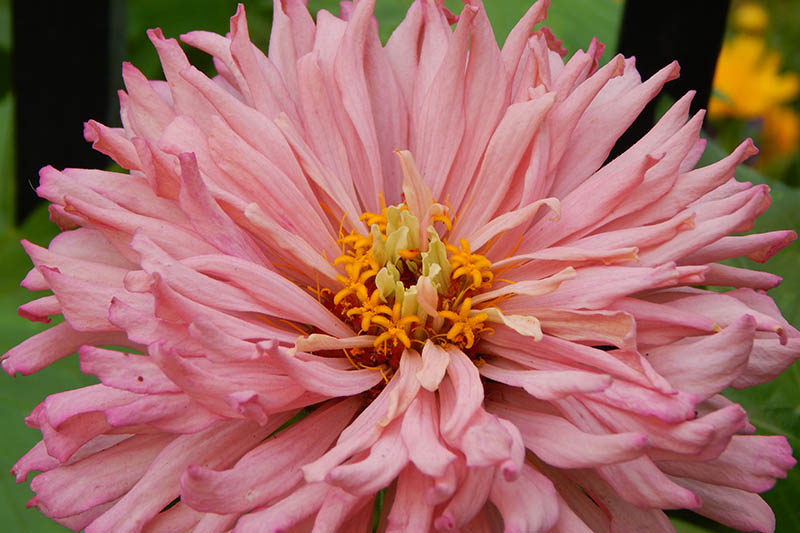
And they offer plenty of color options, from a pretty pastel pink to neon green.
My favorites are cactus zinnias (Zinnia elegans), which are mammoth and arty. When they’re flowering, I like to keep a single bloom in a bud vase on my bathroom vanity.
To me, they look like brightly colored mini haystacks. Instant cheer!
A variety of zinnia seeds are available from Eden Brothers, including a ‘Super Cactus’ giant mix in several packet sizes.
Hop On Down the Trail, Nibbling Bunnies!
Remember, there’s always a slight risk that rabbits will find some flowering plant in your garden to be to their taste.
For one thing, they’re constantly on the run from predators, so when they pause to eat, they’re happiest to get concentrated nutrition from those heavily fertilized bedding plants you’ve just purchased and planted.
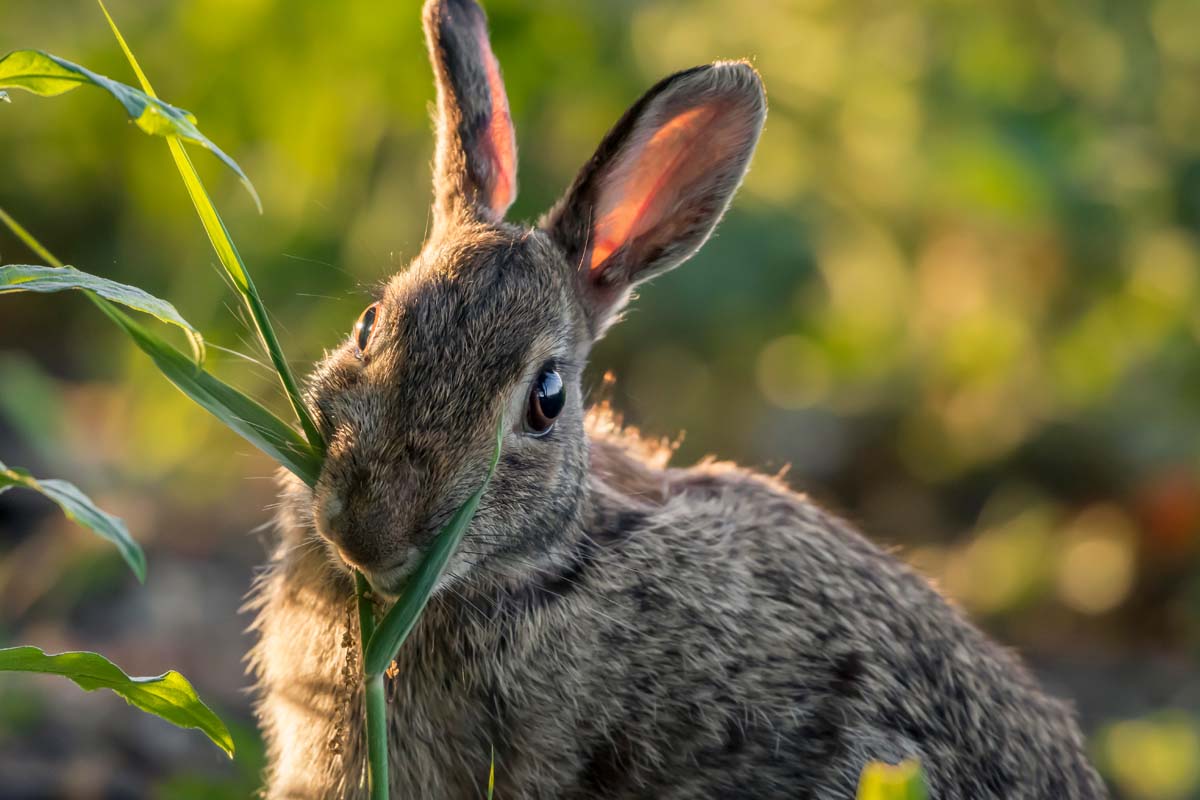
They also like the tender sprouts of your perennials or flowering vegetables. If you’re able to keep them away with fences or other barriers while your plants are small and appealing, that’s a good strategy.
Also be extra cautious and protect young plants, woody shrubs, and even the trees that have delicious new growth, during times when wild food isn’t available for whatever reason.
Happily, a combination of all these strategies can usually make it possible to minimize or eliminate damage from these cute little creatures.
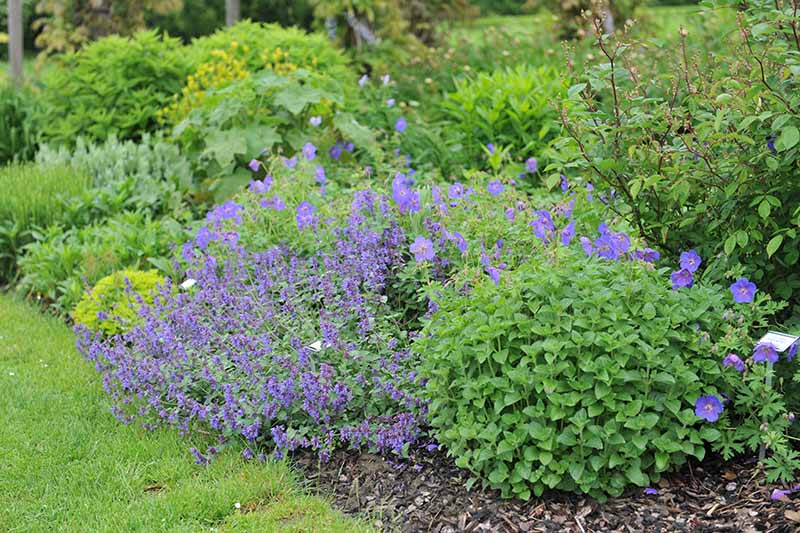
I have found that gardeners and even researchers in different areas have different ideas as to which flowering plants are rabbit-resistant. So be sure to experiment if you’re having trouble.
Let us know in the comments below if you’ve hit on a flower that seems impervious to furry little marauders with big ears, quivering whiskers, and wide eyes!
And if all this info about picking flowering plants has you in garden planning mode, read these other helpful guides next:
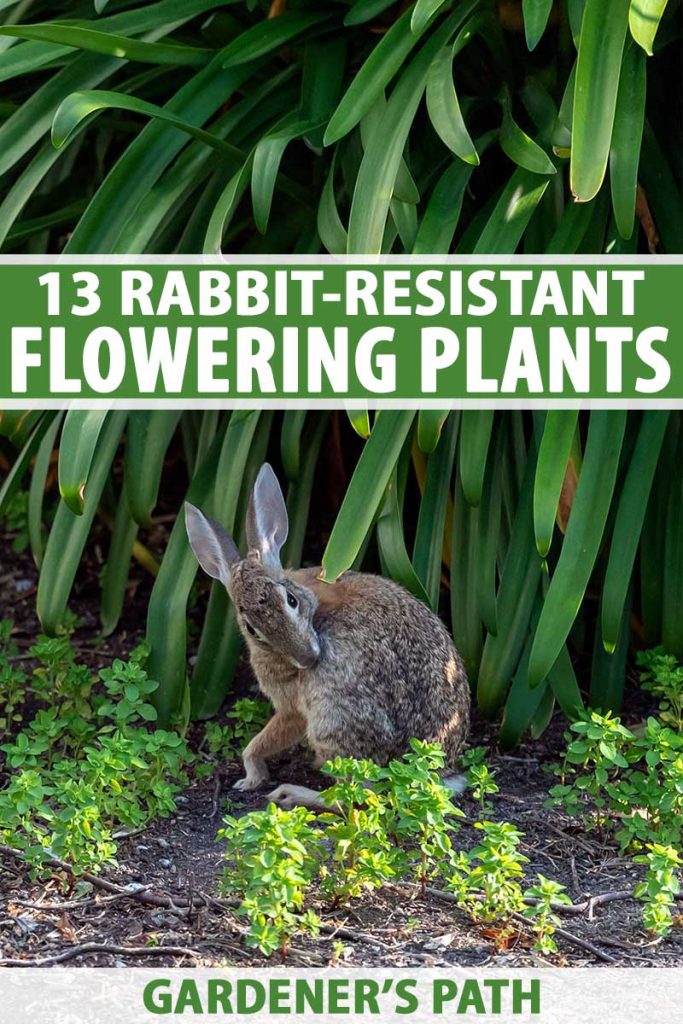



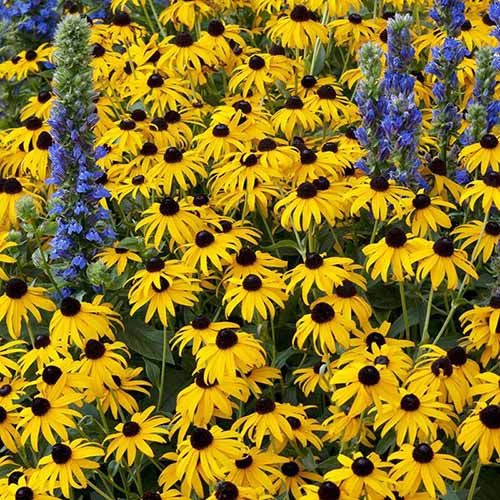
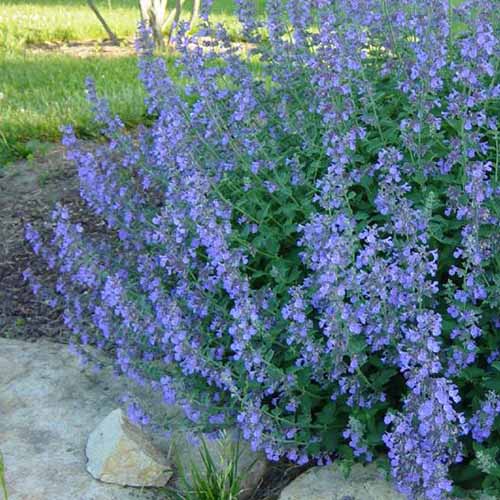
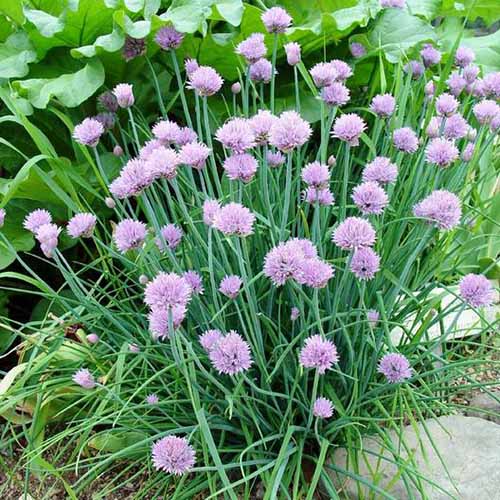

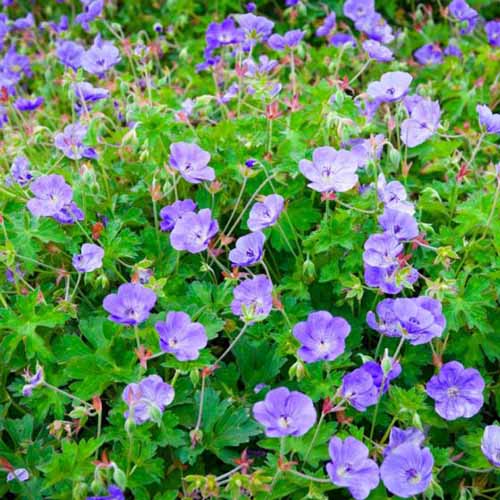

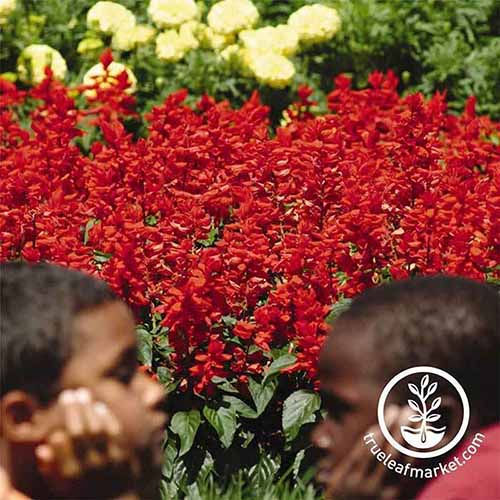
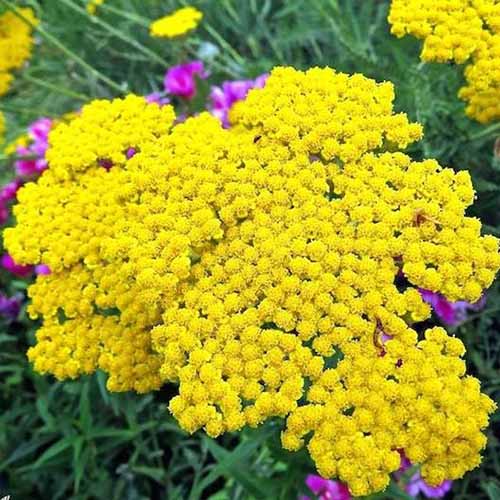
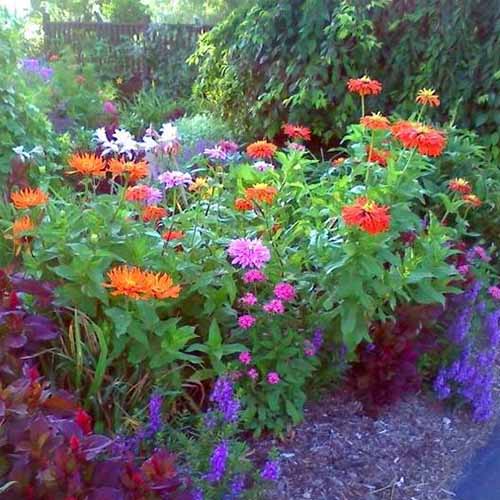

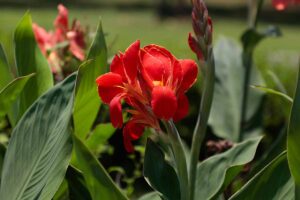
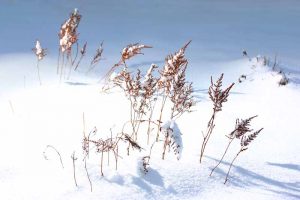
I disagree about Zinnias, the rabbits in my neighborhood have eaten my Zinnias up the stalk of my plants until they can reach no higher. Thanks for the advice on the other plants.
Oh, Colleen, I hate that the rabbits are getting your zinnias! They’re probably extra hungry, or maybe they’re the young rabbits who will try anything.
I appreciate you sharing that the zinnias don’t help in your situation, since so much of this “rabbit resistant” information comes down to personal trial and error.
And I hope some extra fencing might save anything else you plant, or maybe some of the other tips. Boo, hiss to those rabbity troublemakers. Thanks for reading!
I planted yarrow to try and protect my liatris. I even sprayed bunny repellant. They ate all the yarrow but the blossoms plus the liatris. They are munching on the day lilies. I put up a fence but they hop over it or dig under it. I give up. I’m going to try bee balm, but this has been a very frustrating year.
Hello Carol A. Davis. You have my utmost sympathy! It’s fairly difficult to pinpoint which plants your particular rabbits will not eat, especially when they get very hungry or are young, “try anything once” bunnies.
I hope the bee balm works. You might also want to consider growing at least a few flowering plants in a raised planter with a fence and maybe some row cover for when you first transplant.
Good luck, and please share if you do hit on a solution.
We have many black-eyed Susan’s that our rabbits love, even sprayed them with deer/rabbit spray.
Hello Paul Teitelbaum. Ugh! I hate that your particular rabbits love the black-eyed Susans. I can’t emphasize enough that this is a trial and error process, especially since you might have other critters nibbling too, like deer! I have never had any luck with the spray, but usually careful selection of plants and some strategic fencing has done the trick in my garden. Please stay in touch and let me know if any other solutions emerge…
I had beautiful begonias last year and rabbits started eating then 1st day they were planted. I tried rabbit scram, IrishSpring handsoap shavings Nothing worked????
Hello Christi. I sure hate to hear about this episode. Next year, maybe try a rabbit fence, row cover before the flowers start blooming, and planting a little later? Wishing you the best of luck.
Rabbits seem to love my black eyed Susan’s and my beautiful cone flowers! When I discovered the rabbit damage, I used a product called Animal Stopper. It lasts for 30 days. Tried other products previously. Have had some success. I didn’t realize that a multitude of rabbits took up residence under the hostas – I hate rabbits!!!
Hello Butch. Thanks for the tip! And I’m sorry the rabbits have gotten so aggressive as to inspire your loathing. Black-eyed Susan’s and cone flowers are worth protecting, that’s for sure.
I have several varieties of Salvia, thinking I’d beat the rabbits in my yard, but nope. They love my salvias, too.
The rabbits ate all my yarrow this year.
Sorry to hear it Carrie! They must have been pretty hungry. Do have a read of our guide to keeping rabbits out of the garden if you need some tips for protecting your plants.
Have to say that I disagree with your list. I live in Massachusetts and the wild rabbits that find their way into my garden in have feasted on my black eyed susans, cone flowers, and yarrow for years. These lovely plants have now died out due to being under continuous bunny attack. I do not try to re-plant as they seem to attract the bunnies.
Sorry to hear it, Marlene! Resistance doesn’t equal immunity, unfortunately. Though these aren’t typically among their favorite plants once mature, they will still snack on them for lack of better options. Protecting plants is often recommended to protect tender new growth.
Apparently the rabbits in my yard are relentless. I am unable to plant nine of the thirteen species you listed without them getting decimated by rabbits. I have 18 flower gardens, most are 150sqft+. I live in zone 5b.
Providing extra protection when the plants are young can help! All bets are off with many kinds of tender, young growth, but they will tend to ignore mature species on this list.
You need to remove black-eyed susans from your list. Rabbits eat mine down to the stem!!
Sorry to hear it! Have you had this happen with the mature ones, Cinder, or just the newly emerged, baby black-eyed Susans? In my experience, rabbits will eat many types of young, tender foliage but they’re typically turned off by the hairy stems and leaves of flowers like these once mature, as long as other, more enticing options are available elsewhere.